Hair transplant surgery has become increasingly popular as a solution for individuals experiencing hair loss or thinning. While the procedure offers promising results in restoring natural hair growth, many patients are often left wondering about the compatibility of post-transplant care products, such as Rogaine (minoxidil). In this article, we delve into the compatibility of Rogaine with hair transplant procedures, exploring its benefits, potential risks, and recommendations for post-transplant hair care.
Understanding Hair Transplant Surgery
Before delving into the compatibility of Rogaine with hair transplant surgery, it’s essential to grasp the basics of the procedure. Hair transplant surgery involves the transplantation of hair follicles from a donor area, typically the back or sides of the scalp, to the recipient area experiencing hair loss. The two primary methods of hair transplant are follicular unit transplantation (FUT) and follicular unit extraction (FUE), both of which aim to provide natural-looking results by strategically implanting healthy hair follicles.
The Role of Rogaine in Hair Growth
Rogaine, also known as minoxidil, is an FDA-approved topical medication used to stimulate hair growth in individuals experiencing hair loss or thinning. It works by widening the hair follicles, promoting increased blood flow, and prolonging the growth phase of the hair cycle. Rogaine is available over-the-counter in various formulations, including foam and solution, making it a convenient option for those seeking to address hair loss concerns.
Using Rogaine After Hair Transplant Surgery: Is it Safe?
One of the common questions among individuals considering or undergoing hair transplant surgery is whether they can use Rogaine as part of their post-operative care routine. While Rogaine can be beneficial in promoting hair growth, its compatibility with hair transplant surgery depends on various factors, including the type of procedure performed and the individual’s unique circumstances.
Compatibility with Follicular Unit Extraction (FUE) Transplant
For individuals who undergo FUE hair transplant surgery, the tiny incisions made to extract individual hair follicles typically heal relatively quickly, allowing for the application of topical treatments such as Rogaine. However, it’s crucial to follow the guidance of your surgeon regarding the timing of when to resume the use of Rogaine after surgery to ensure proper healing and optimal results.
Compatibility with Follicular Unit Transplantation (FUT) Transplant
In the case of FUT hair transplant surgery, where a strip of tissue containing hair follicles is removed from the donor area, the recovery process may involve a longer healing period. Patients are advised to wait until the donor area has fully healed before applying any topical treatments, including Rogaine, to avoid potential irritation or interference with the healing process. Consulting with your surgeon is vital to determine the appropriate timing for incorporating Rogaine into your post-operative care routine.
Benefits of Using Rogaine After Hair Transplant Surgery
Incorporating Rogaine into your post-transplant care regimen can offer several potential benefits:
1. Promotion of Hair Growth: Rogaine’s active ingredient, minoxidil, has been clinically proven to stimulate hair growth and prevent further hair loss, complementing the results achieved through hair transplant surgery.
2. Enhanced Density: By promoting the growth of existing hair follicles and potentially stimulating dormant follicles, Rogaine can contribute to improved hair density and overall aesthetic results following hair transplant surgery.
3. Maintenance of Results: Using Rogaine as part of a long-term hair care routine can help maintain the results of hair transplant surgery by supporting healthy hair growth and minimizing further hair loss over time.
Potential Risks and Considerations
While Rogaine is generally considered safe for use in promoting hair growth, it’s essential to be aware of potential risks and considerations, especially when incorporating it into your post-transplant care routine:
1. Risk of Irritation: Some individuals may experience scalp irritation or allergic reactions when using Rogaine, particularly if the skin is still sensitive from the hair transplant surgery. It’s essential to monitor your scalp’s reaction and discontinue use if any adverse effects occur.
2. Timing of Application: Timing the application of Rogaine following hair transplant surgery is crucial to ensure that it does not interfere with the healing process or cause irritation to the scalp. Always follow the guidance provided by your surgeon regarding when to resume the use of topical treatments.
3. Consultation with Healthcare Provider: Before incorporating Rogaine or any other hair care products into your post-transplant routine, it’s advisable to consult with your surgeon or healthcare provider. They can provide personalized recommendations based on your individual circumstances and medical history.
Recommendations for Post-Transplant Hair Care
In addition to considering the use of Rogaine, adopting a comprehensive post-transplant hair care routine can help optimize the results of your hair transplant surgery:
1. Follow Surgeon’s Instructions: Adhere to the post-operative care instructions provided by your surgeon, including guidelines for washing your hair, avoiding strenuous activities, and protecting the donor and recipient areas from potential trauma.
2. Gentle Hair Care Practices: Use gentle hair care products and techniques to minimize stress on the newly transplanted hair follicles. Avoid excessive brushing, tight hairstyles, and harsh chemical treatments during the initial healing phase.
3. Healthy Lifestyle Habits: Maintain a healthy lifestyle, including a balanced diet, regular exercise, and stress management techniques. These factors can influence overall hair health and contribute to the success of your hair transplant surgery.
4. Regular Follow-Up: Schedule regular follow-up appointments with your surgeon to monitor the progress of your hair growth and address any concerns or questions you may have regarding your post-transplant care routine.
Conclusion
In conclusion, using Rogaine after hair transplant surgery can be a safe and effective way to promote hair growth and enhance the results of the procedure. However, it’s essential to approach its use with caution, ensuring proper timing and monitoring for any potential adverse effects. By consulting with your surgeon and following a comprehensive post-transplant care routine, you can maximize the benefits of both Rogaine and hair transplant surgery in achieving natural-looking, long-lasting results.


